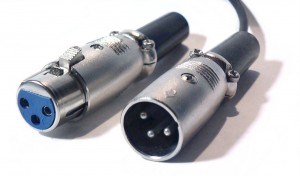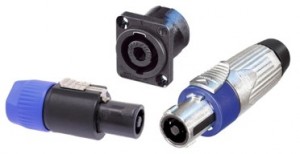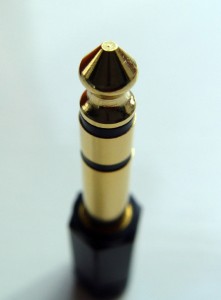Cables and Connections
There are three main types of connection in professional audio: XLR, Speakon and Audio ‘Jack’
XLR

XLR Connectors
The XLR is the epitome of the professional audio world. It is standard in any audio environment and can be clearly identified by its three round pin terminals or sockets. All professional microphones use this connections as they allow for balanced signalling meaning that any signal sent down an XLR cable is free from any external interference. That means you get the best possible signal quality from a microphone or audio source. An XLR signal path is always male to female as standard. Only a customised system will ever have the reverse of this setup.
Speakon

Speakon
Speakon (developed by Neutrik) perhaps the second most common type of connections in professional. There are mostly used to connect loudspeakers to amplifiers. Unlike XLR cables, Speakon cables have the same male connection at both ends, so that means they connect into female patch panel sockets. Speakon connectors are available with 2,4 or 8 poles. This means that speakon cables can allow for Bi-amping or Tri-amping to one speaker with just one cable rather than two or three. A two pole connector will work with a 4 pole socket, but a four pole connector will not work with a 2 pole socket, this is due to the fact that the connections within the 2 pole socket do not match a 4 pole connector. Speakon connects with a twist and lock motion allowing for a completely secure connection, and they do not short out so there is no ‘popping’ of speakers when they are connected or disconnected. As a result the loudspeaker remains protected.
Audio ‘Jack’ TRS Connector

Audio Jack Connector
The most common place you will find a 1/4 inch jack connector is on the end of guitar cables. They were abundant in the analogue audio world on jack fields where one had to route signals to outboard audio processors and effects units. Now, however they are not so much seen in live events due to most audio processing happening within a digital mixing desk. But you are almost guaranteed to find jack patch fields in recording studios as they still use a lot of outboard audio processing equipment. The downside to TRS connectors is that they carry unbalanced signal, this leaves them susceptible to external interference and so are virtually useless at sending signals over a long distance. As a result they are used in patch fields for short distance routing as they are easier to plug in and out than an XLR for example.